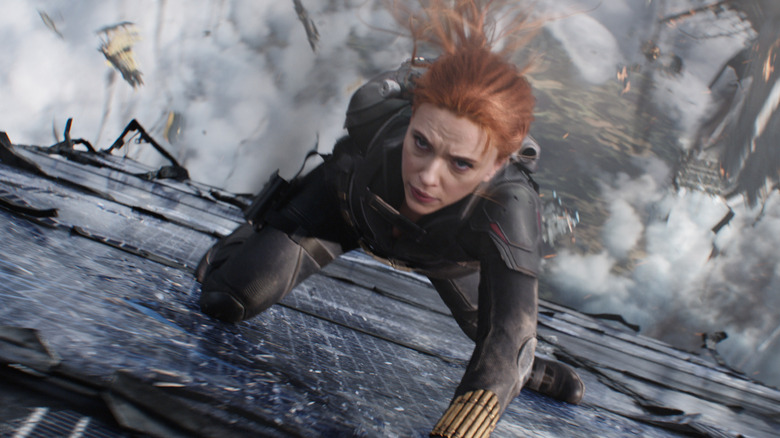
You know the saying, "It takes a village"? Usually, that's in reference to raising a child, but it absolutely holds true for the visual effects (VFX) crew behind Marvel juggernauts like "Black Widow." In this case, their "baby" is the movie itself and the "village" is made up of hundreds upon hundreds of hardworking artists who masterfully create all the breathtaking visuals -- both obvious and invisible -- that fans tend to take for granted. You can get a sense of just how many individuals and how much work is required in this undertaking, simply while waiting for the inevitable mid- or post-credits scenes -- though, ideally, their tireless efforts and borderline miracle-working feats would be celebrated and recognized by viewers either way.
With "Black Widow" specifically, no less than 24 different VFX companies (referred to as "vendors") and their army of behind-the-scenes talent played invaluable roles in bringing to life the film's extensive action set pieces, background effects, digital face compositing, and so much more. Each and every effects company contributed to several different aspects of the blockbuster's visual effects, sometimes with multiple different vendors working on the exact same shot or sequence at a time. The difficult task of keeping track of all these various moving parts fell to VFX supervisor Geoffrey Baumann, a seasoned veteran of multiple Marvel films including "The Avengers," "Iron Man 3," "Captain America: Civil War," "Doctor Strange," "Black Panther," and the upcoming "Black Panther: Wakanda Forever." Along with Baumann, I was joined by VFX Supervisor David Hodgins ("Captain Marvel," "Thor: Ragnarok," "Transformers: Dark of the Moon," "2012") of Digital Domain and VFX Supervisor Craig Hammack ("Red Notice," "Captain Marvel," "Black Panther," "Thor: Ragnarok," "Rogue One: A Star Wars Story") of ILM for a chat about their work on "Black Widow."
We talked about their perspective on moving from one Marvel production to another, the process of building relationships with each director, and the all-important question of whether they're able to watch their own artistry on the big screen ... without making themselves miserable with self-critique, of course.
"If You Move From One Show To Another, You Know What To Expect And You Know The Arc"
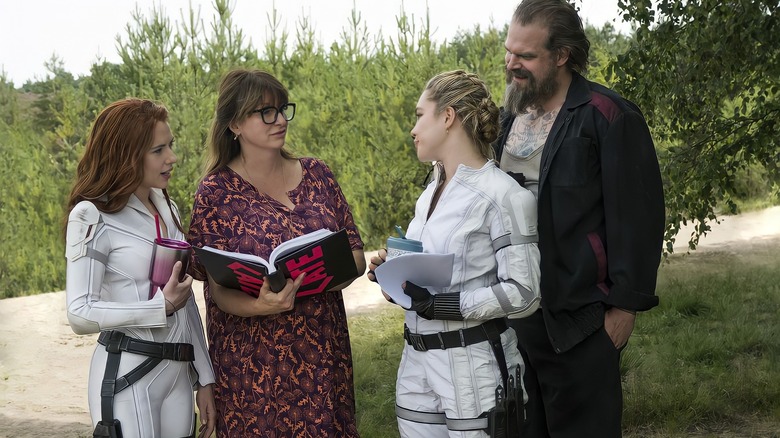
Obviously you've all developed a really strong, really close working relationship with Marvel over the years. They keep on inviting you guys back, so you must be doing something right. [laughs] What's the process like of jumping from one Marvel movie right to the next?
Geoffrey Baumann: Directors, I'd probably say. That's the biggest difference between one to the other, is the individual that comes in to lead the ship. And I think Marvel has done a great job of finding very unique directors that are very different, but then somehow with the guidance of Kevin [Feige], Lou [Louis D'Esposito], and Victoria [Alonso], are able to have that one film connect to many others while still at the same time allowing that director to give their own input. So to me, that's probably... the biggest difference would be working with someone like Ryan Coogler to Cate Shortland. Both amazing human beings and great filmmakers, but having a different approach. But at the same time, still coming back to the character, the story being most important to both of them. But I'd say that's probably the biggest piece for me is the director relationship.
Craig Hammack: On the vendor side, at least for us, there's a constant stream of Marvel projects. There's never not a Marvel project in the works. And Marvel does an amazing job of crewing supervisors in Geoff's role, that are consistently strong. And so, they provide a framework to the way the work is done, that is pretty consistent. So, jumping into a Marvel project on the vendor side, it's kind of a known process, that's not always super smooth or it's not always a linear process, but it's a known process. So, you're working with different supervisors on different projects, but it's under the same framework. So it's a pretty consistent workflow.
David Hodgins: Yeah. And to kind of go on that, because Marvel makes so many movies and they have so many shows, there's a certain amount of support there and consistency with how things are done and it's evolved over the years. If you look how things were delivered three or four years ago, they just get better, at least from the vendor side, I don't know how it is on the Marvel side, but it feels like it's getting better on their process of how things are delivered, how things are captured. And like Craig said, it's pretty consistent now. If you move from one show to another, you know what to expect and you know the arc of the show. Everyone's used to it now for a lack of a better term, of how the show's going to go when the edit's going to lock. And you just kind of have a certain pace you're used to.
"I Think We're Always Trying To Look At What Other Films Have Done"
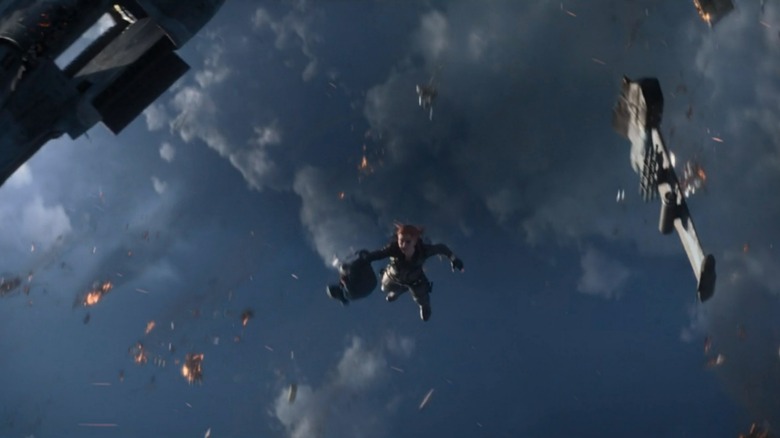
Marvel's made headlines before for the use of brand-new tech, whether it's on "Thor: Ragnarok," the new lighting and the high speed cameras that they used for certain flashback scenes. Was there anything similar for "Black Widow" on the VFX side of things?
Baumann: We did use LED panels for interactive light and those type of things. I don't know if we necessarily broke any new ground particular with anything ... I mean, there were technical challenges. I think that complexity of the work was there also the volume of work on this film, I think, is bigger than people might realize, which was also a burden as well. But I don't know if there was necessarily a particular technical piece. I don't know, Dave, the descent-wise, if there's anything? I know we, a little bit of, was it Charlatan or, but I don't think we used much. He started a little bit on that.
Hodgins: No, that was all shot practically robot arm. And then in practical sky diver stuff.
Baumann: Yeah, real skydiving? I mean that... Getting people to commit to real skydiving took a while for us to get production on board for that. And a lot of that descent sequence was practical photography that was then roto-mated and replaced. So there was an energy that the cameras had and that the performers had in that dissent. That might be one of the bigger pieces I'd say.
The face mask scene towards the end, in the third act, is that just a more overt example of digital face replacement or is there something more going on there?
Baumann: The Widow's Veil aspects of those end up being very unique, because they're very camera or shot specific. So there's kind of a methodology, I think the first time that that was seen was in "Winter Soldier," I believe a while back. And it's kind of evolved so that the concept is the same, but it involves a little bit of face replacement, but it's also multiple elements that are photographed together. And so there's a bit of smoke and mirrors that's going on where you're blending between plates. So there is face replacement or digital face involved, but you're trying to just use that to help the transition between it. So it's a bit of a hybrid between the two and I would say that we had two shots where, we were going from Yelena to Natasha and vice versa and they were both shots. Similarly, we would shoot both actors in the same space with the same camera move, and then there would be a Digi face that helped that transition.
It's very similar to something like "Mission Impossible. Do you ever look at those movies for reference or is this something you're doing all on your own?
Baumann: Yeah, absolutely. I think we're always trying to look at what other films have done. Even within the Marvel universe, to kind of what you were asking about earlier, is making sure that we aren't doing something similar that they're doing, or we can riff off of something else that's happening in a different story. And that goes both from effects to what aircraft look like, to colors, because certain colors are designated to certain characters or technology that maybe we don't want to necessarily touch upon because it's come up in something else.
"How Do You Have The Spectacle, But Also The Intimacy?"
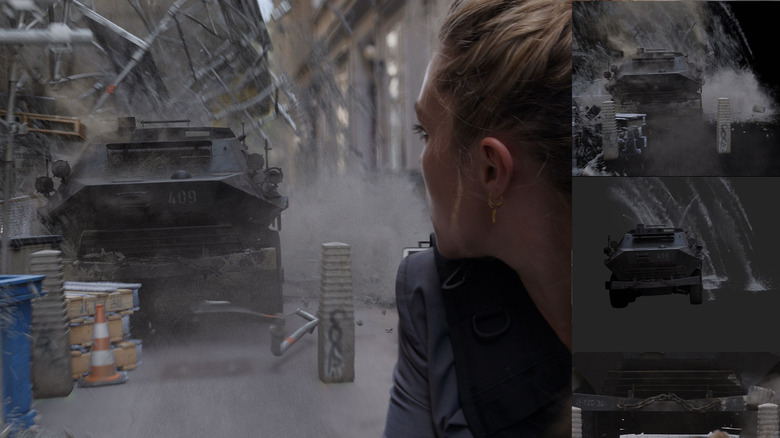
With a movie like "Black Widow" specifically ... are you going for a more naturalistic look or do you want to also have the superhero aspect of it where it stands out, it's extravagant, it's spectacle?
Baumann: You touch on probably one of... there's a balance in that. And I think probably, for Craig, Dave, and I, we would always lean towards a grounded, earthy aspect of real photography that we can integrate. Seamless CG, almost invisible effects is, I think, always our goal, which sometimes becomes a bit of a challenge when you are doing the superhero movie. How do you have the spectacle, but also the intimacy of those two, and I think this film, I really enjoyed the fact of how grounded it was, until you get to the third act where everything gets overblown and big. But I think because the first two acts were so grounded, we were able to maintain as much reality as one could for the floating fortress in the sky and the free fall. So I think for me overall, the grounded aspect is something I would lean towards as much as possible. And I think we were pretty successful in making this feel as photographic as possible.
Do you have a preference for what kind of look you're going for, whether it be naturalistic or more on the other side of the equation?
Hodgins: I think, from a practical standpoint, if you're doing something, if it's more grounded in reality, you know what you're going for, right? There's someone who's like, make it metal, make it canvas, or make it something. You know the goal and everyone buys into it and that there's a certain visual language and visual cues with that. And when you start doing other types of work, like more world-building and stuff, sometimes it's harder to make it... There's enough visual cues there that it's a struggle sometimes to make it work. Sometimes there'll be a certain color red, that's just hard to photograph and you start putting it in movies and people start... I spend so much time talking about a shade of red... Just weeks [laughs]. But yeah. If you ground it in reality and you can get a piece of plate in there and then people just buy it. It just feels better overall and you get the natural lighting and, I think Geoff touched on a little bit, even the skydiving stuff, even if it were completely replaced, we'll track the cameras, we'll track the skies. We will get that energy that you get that you can create, but it's a lot harder if you've got something that to match to. And a lot of times it's just the feel of it. It's hard to quantify, right? It's got the same energy as what was shot. And that's what we're trying to keep from the practical on those big sequences.
Hammack: Yeah. I'd say, for me, I much prefer grounded work. I think in some ways it's a bigger challenge because it's stuff that everyone has seen before. Like you've seen real-world metal, you've seen real-world streets, you know how people move, you know how vehicle physics really works. Even if you don't know the math behind it, you know when things look right and when things look wrong. And so being able to work within that scope of things that even the subtle misses, are a cue to the audience, is a big challenge, I think, and one I prefer. And to David's point, having real-world reference, is a huge benefit and it's part of the fun, right? You go find and study fireflies for a week, to make sure you get firefly shots right. And then in some ways, it becomes very satisfying because it does, when successful, become invisible.
Baumann: It also helps us when we're looking for direction from Cate, for example, because we have something real to look at. Once you get into the world that is somewhat fantastical, there is no real-world. So it's hard to look at, "What does this really look like?" Because you can't necessarily find that firefly reference. So, that's another great thing, I think, of shooting something that is grounded and is real. There's something that we can all look at and then agree upon of what it looks like. And do we want to match that or do we want to cheat? And so that's a nice thing that you can have in a grounded film, I think.
"We Were Just Talking About Characters"
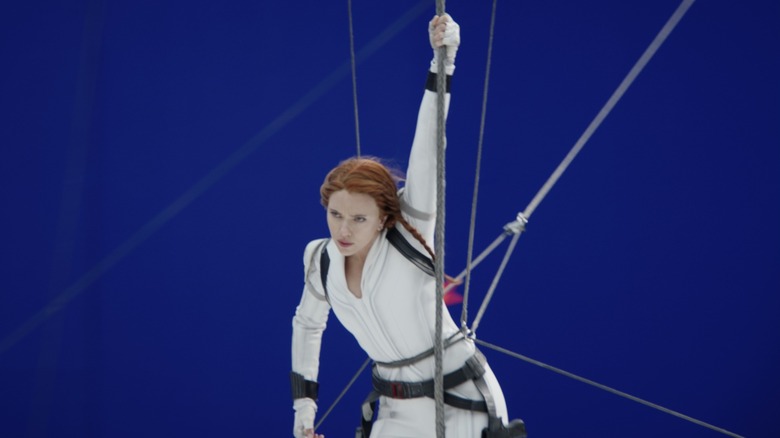
You've worked with Ryan Coogler before ... Anna Boden and Ryan Fleck on other Marvel movies. Is it just, you're trying to make [Cate Shortland] as comfortable as possible with this whole world of effects?
Baumann: That's definitely part of it. I think that the big part for me with Cate was to try to not have her feel overwhelmed by visual effects. How can we, as a visual effects team, help support her so that she realizes this tool she has to help her in the storytelling. And then also, how does visual effects break down into pre-vis and post-vis, and it can be really intimidating just with the terminology we use. And we start throwing out complicated words and whatnot, that it's easy, I think, for directors to just shy away. So that was a big part, I think, early on was just for me to establish a relationship with Cate where she could always feel comfortable to come talk to me about things. Just even story and character related, which was, that's when I felt we'd really turned the corner was when we were just talking about characters. It wasn't necessarily about visual effects, but at the same time, me understanding what she's thinking about the characters helps me then guide Craig and Dave. Because that's a lot of my job, is to make sure that I'm steering the ship in the right direction as best I can with Cate's and the studio's direction. Not necessarily just mine, so that we aren't going down the wrong road. And Cate was fantastic with regards to that, didn't feel too overwhelmed and was embracing, I think, with all of us in the process.
ILM and Digital Domain each played a really big role in "Black Widow." Can you speak to which elements of the movie you guys handled respectively?
Hammack: We were tasked with a lot of the stuff in the first couple of acts. So [ILM] did the opening scene in Ohio, the flashback where they escaped from Ohio. And we did the Cuba section where they land. We did the Budapest apartment fight, rooftop chase and car chase through all that. And then the Black Widow fight in Dreykov's office, where they tried to kill Natasha with all the red particulates and then a few bits here and there beyond that. But those are the main ones.
Hodgins: Yeah. And Digital Domain covered most of the third act. I mean basically from the time the Red Room explodes and then basically all through the Red Room, then what we call the descent where they jump off or fall of the Red Room. And then, so we go down the descent to the ground below and then we do the fight on the ground below. So the three sequences.
"So There's A Little Bit Of PTSD Potentially Still Going On There"
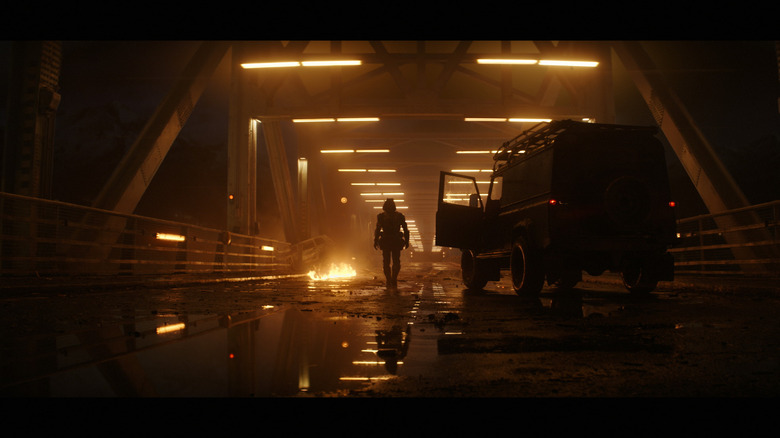
I know a lot of actors are hesitant to see themselves on-screen sometimes when they're watching their own movies. Is that the same for VFX guys? Are you able to look at the movies you've created and not critique it as much as possible? Are you able to enjoy the ride?
Baumann: Hard for me ... creatively, I'd love to be working on something and polish it until we're finished, but sometimes we just don't have that luxury. I'd have to say actually that "Black Widow" was one film that, unfortunately with COVID, it was stalled for so long that there was a much longer gap between us finishing, and it coming out in the theater. So I really did enjoy it, going to the theater and watching it as a film, more than normal because oftentimes it's the 11th hour that we finish and then it comes out right away. So there's a little bit of PTSD potentially still going on there [laughs]. But this one was good, but normally it's hard sometimes.
Hammack: Yeah, I would probably say I have a very short memory [laughs], which is helpful in this world. But generally when I go to see a film I've worked on, at least the first time, I'm very anxious through the whole thing. Because it's always a balancing act of, you get the work to a level that should go into a movie, but it's never perfect. Right? Perfection is a lot of times wasted money, right? So it gets to a point and everyone agrees it's great, and goes into the movie, but you know where the flaws are. And so it's always a bit of anxiousness seeing it on the big screen, the first time with an audience. But I am able to watch every other visual effects movie that I don't work on and just enjoy this movie.Hodgins: I'm always like... because you see rough cuts of it without the final audio and final sound and everything through the process. but I really like going to see other people's work, right? Like all the parts that you didn't work on and then when your stuff comes on, you just know it so well. Right? You've watched it literally thousands of times daily and so you know your work or the sequences you work on and you'll know if a shot got cut or something or got shortened or they've tweaked the color on it, you just know that stuff so well, but it's really fun to see everybody else's work from throughout the project when it's all final.
Read this next: 11 Marvel Comics Villains We Really Want To See In The MCU
The post Black Widow VFX Team Talks Creating Grounded Action, Practical Skydiving, and Handling Multiple Marvel Movies [Interview] appeared first on /Film.
0 Comments